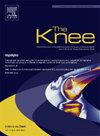基于功能能力、运动恐惧、肌肉厚度和关节位置感的膝关节炎相关膝疼痛个体的结构方程模型
IF 1.6
4区 医学
Q3 ORTHOPEDICS
引用次数: 0
摘要
有几个临床参数有助于膝骨关节炎(KOA)相关的膝关节疼痛和/或其进展,如运动恐惧症、功能能力、肌肉厚度和关节位置感。膝关节疼痛与上述临床参数之间的关系需要清楚的了解。因此,本研究以运动恐惧症、功能能力、肌肉厚度和关节位置感为变量,构建了koa相关膝关节疼痛的结构方程模型。方法我们检查了200例koa相关膝关节疼痛患者(74%为女性)。获得运动恐惧症、功能能力测试、股四头肌和腘绳肌厚度、膝关节屈伸时的位置感作为潜在变量,通过结构方程建模探讨膝关节疼痛的因果关系。结果所有潜在变量均符合结构模型,统计参数优良。模型的多重相关的平方估计为0.928。特别是,运动恐惧症、功能能力测试和腘绳肌厚度与膝关节疼痛有显著关联。结论膝关节疼痛与运动恐惧、功能能力、股四头肌和腘绳肌厚度、膝关节位置感有关。虽然这种关系不能确定因果关系,但研究结果强调了在设计预防干预措施或治疗策略时采用综合方法管理膝关节疼痛的重要性。本文章由计算机程序翻译,如有差异,请以英文原文为准。
Structural equation model of knee pain in individuals with knee osteoarthritis-associated knee pain, based on functional capacity, kinesiophobia, muscle thickness, and joint position sense
Background
There are several clinical parameters that contribute to knee osteoarthritis (KOA)-associated knee pain and/or its progression such as kinesiophobia, functional capacity, muscle thickness, and joint position sense. The relationship between knee pain and those aforementioned clinical parameters is needed for clear understanding. Therefore, this study constructed the structural equation model of knee pain with the variables of kinesiophobia, functional capacity, muscle thickness, and joint position sense in individuals with KOA-associated knee pain.
Methods
We examined 200 individuals (74% female) with KOA-associated knee pain. Kinesiophobia, functional capacity test, quadriceps and hamstring muscle thickness, and knee joint position sense in flexion and extension were obtained and served as latent variables to investigate causal relationships with knee pain through structural equation modeling.
Results
All latent variables were fit for the structural model with excellent statistical parameters. The squared multiple correlations’ estimate for the model was 0.928. In particular, kinesiophobia, functional capacity test, and hamstring muscle thickness had significant associations with knee pain.
Conclusion
Knee pain was associated with kinesiophobia, functional capacity, quadriceps and hamstring muscle thickness, and knee joint position sense. Although this relationship does not establish causality, the findings underscore the importance of adopting an integrated approach when designing preventive interventions or therapeutic strategies for managing knee pain.
求助全文
通过发布文献求助,成功后即可免费获取论文全文。
去求助
来源期刊

Knee
医学-外科
CiteScore
3.80
自引率
5.30%
发文量
171
审稿时长
6 months
期刊介绍:
The Knee is an international journal publishing studies on the clinical treatment and fundamental biomechanical characteristics of this joint. The aim of the journal is to provide a vehicle relevant to surgeons, biomedical engineers, imaging specialists, materials scientists, rehabilitation personnel and all those with an interest in the knee.
The topics covered include, but are not limited to:
• Anatomy, physiology, morphology and biochemistry;
• Biomechanical studies;
• Advances in the development of prosthetic, orthotic and augmentation devices;
• Imaging and diagnostic techniques;
• Pathology;
• Trauma;
• Surgery;
• Rehabilitation.
 求助内容:
求助内容: 应助结果提醒方式:
应助结果提醒方式:


